Financial Analysis Report: Comparison of Beverage Company Finances
VerifiedAdded on 2022/12/14
|12
|3193
|124
Report
AI Summary
This report presents a comprehensive financial analysis of three beverage companies: AG Barr plc, Britvic plc, and Coca-Cola plc. The analysis is divided into two sections. The first section focuses on the financial ratios, including ROE, ROCE, profit margin, and other key metrics, comparing their performance over three years. The second section examines the companies' long-term financial sources, including equity financing, retained earnings, and debt financing. The report highlights the strategic decisions influencing financial results and provides a critical assessment of the various processes and funding streams employed by each company. The study provides a comparative analysis, identifying strengths, weaknesses, and trends within the beverage industry, offering insights into financial management and performance.
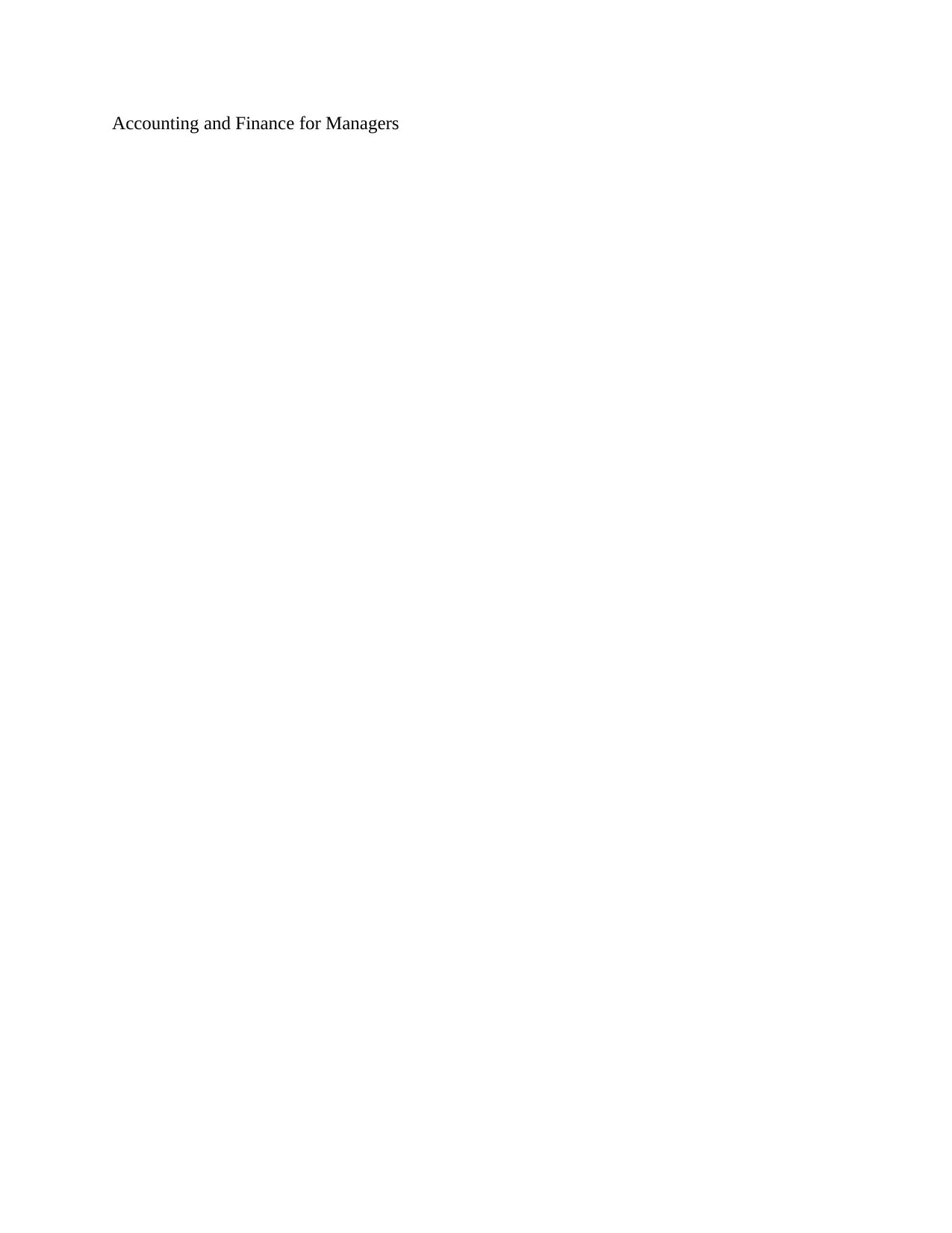
Accounting and Finance for Managers
Paraphrase This Document
Need a fresh take? Get an instant paraphrase of this document with our AI Paraphraser
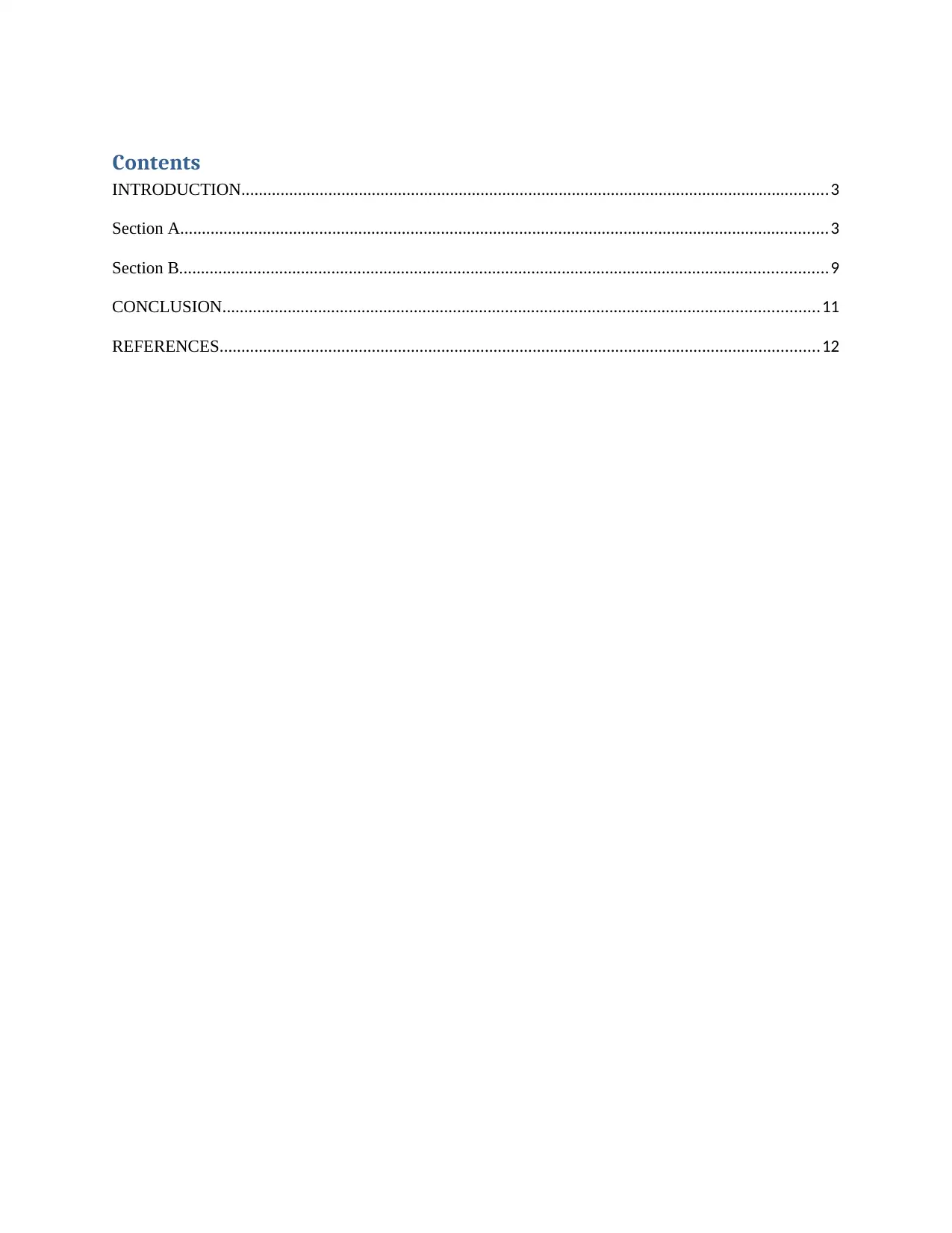
Contents
INTRODUCTION.......................................................................................................................................3
Section A.....................................................................................................................................................3
Section B.....................................................................................................................................................9
CONCLUSION.........................................................................................................................................11
REFERENCES..........................................................................................................................................12
INTRODUCTION.......................................................................................................................................3
Section A.....................................................................................................................................................3
Section B.....................................................................................................................................................9
CONCLUSION.........................................................................................................................................11
REFERENCES..........................................................................................................................................12
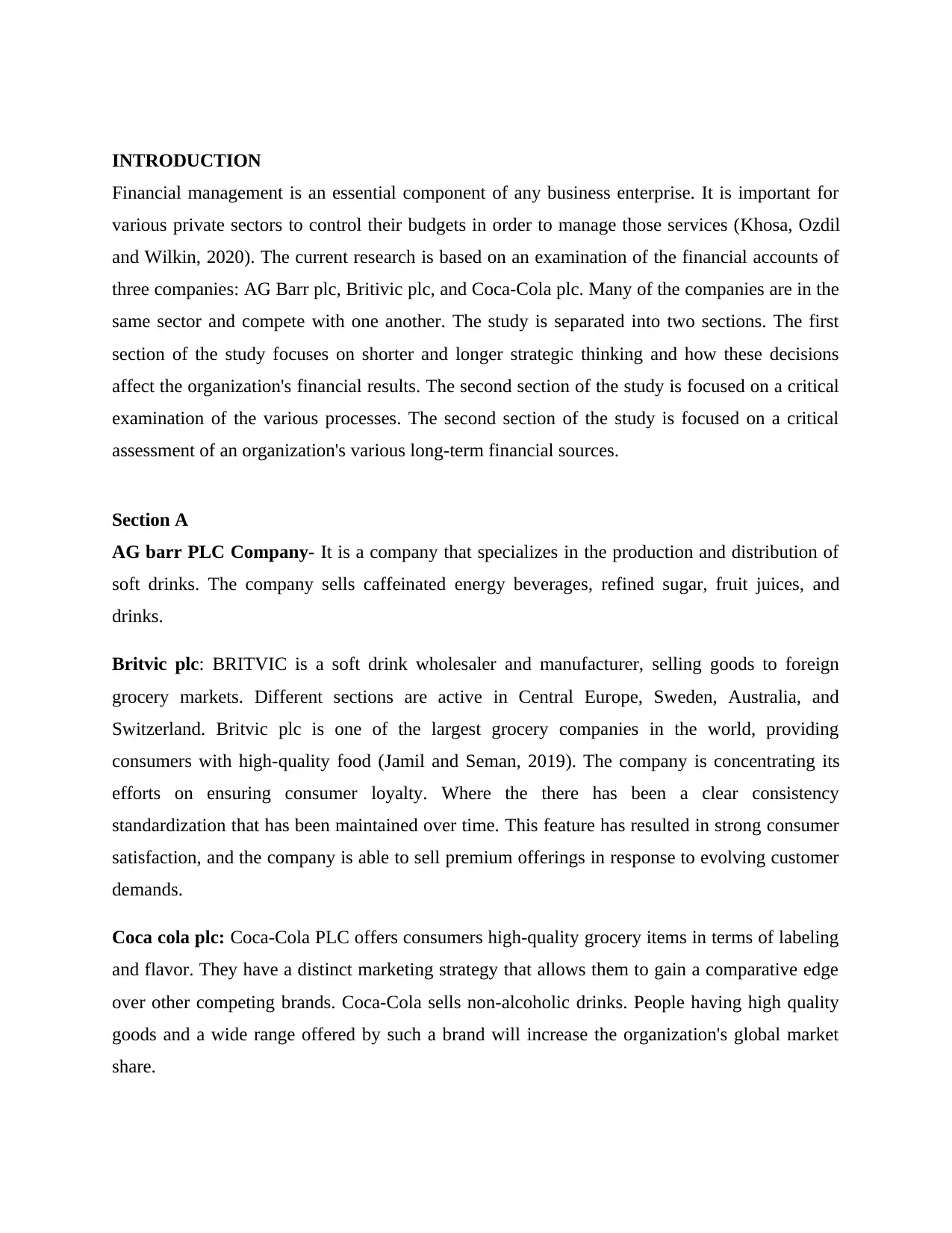
INTRODUCTION
Financial management is an essential component of any business enterprise. It is important for
various private sectors to control their budgets in order to manage those services (Khosa, Ozdil
and Wilkin, 2020). The current research is based on an examination of the financial accounts of
three companies: AG Barr plc, Britivic plc, and Coca-Cola plc. Many of the companies are in the
same sector and compete with one another. The study is separated into two sections. The first
section of the study focuses on shorter and longer strategic thinking and how these decisions
affect the organization's financial results. The second section of the study is focused on a critical
examination of the various processes. The second section of the study is focused on a critical
assessment of an organization's various long-term financial sources.
Section A
AG barr PLC Company- It is a company that specializes in the production and distribution of
soft drinks. The company sells caffeinated energy beverages, refined sugar, fruit juices, and
drinks.
Britvic plc: BRITVIC is a soft drink wholesaler and manufacturer, selling goods to foreign
grocery markets. Different sections are active in Central Europe, Sweden, Australia, and
Switzerland. Britvic plc is one of the largest grocery companies in the world, providing
consumers with high-quality food (Jamil and Seman, 2019). The company is concentrating its
efforts on ensuring consumer loyalty. Where the there has been a clear consistency
standardization that has been maintained over time. This feature has resulted in strong consumer
satisfaction, and the company is able to sell premium offerings in response to evolving customer
demands.
Coca cola plc: Coca-Cola PLC offers consumers high-quality grocery items in terms of labeling
and flavor. They have a distinct marketing strategy that allows them to gain a comparative edge
over other competing brands. Coca-Cola sells non-alcoholic drinks. People having high quality
goods and a wide range offered by such a brand will increase the organization's global market
share.
Financial management is an essential component of any business enterprise. It is important for
various private sectors to control their budgets in order to manage those services (Khosa, Ozdil
and Wilkin, 2020). The current research is based on an examination of the financial accounts of
three companies: AG Barr plc, Britivic plc, and Coca-Cola plc. Many of the companies are in the
same sector and compete with one another. The study is separated into two sections. The first
section of the study focuses on shorter and longer strategic thinking and how these decisions
affect the organization's financial results. The second section of the study is focused on a critical
examination of the various processes. The second section of the study is focused on a critical
assessment of an organization's various long-term financial sources.
Section A
AG barr PLC Company- It is a company that specializes in the production and distribution of
soft drinks. The company sells caffeinated energy beverages, refined sugar, fruit juices, and
drinks.
Britvic plc: BRITVIC is a soft drink wholesaler and manufacturer, selling goods to foreign
grocery markets. Different sections are active in Central Europe, Sweden, Australia, and
Switzerland. Britvic plc is one of the largest grocery companies in the world, providing
consumers with high-quality food (Jamil and Seman, 2019). The company is concentrating its
efforts on ensuring consumer loyalty. Where the there has been a clear consistency
standardization that has been maintained over time. This feature has resulted in strong consumer
satisfaction, and the company is able to sell premium offerings in response to evolving customer
demands.
Coca cola plc: Coca-Cola PLC offers consumers high-quality grocery items in terms of labeling
and flavor. They have a distinct marketing strategy that allows them to gain a comparative edge
over other competing brands. Coca-Cola sells non-alcoholic drinks. People having high quality
goods and a wide range offered by such a brand will increase the organization's global market
share.
⊘ This is a preview!⊘
Do you want full access?
Subscribe today to unlock all pages.

Trusted by 1+ million students worldwide
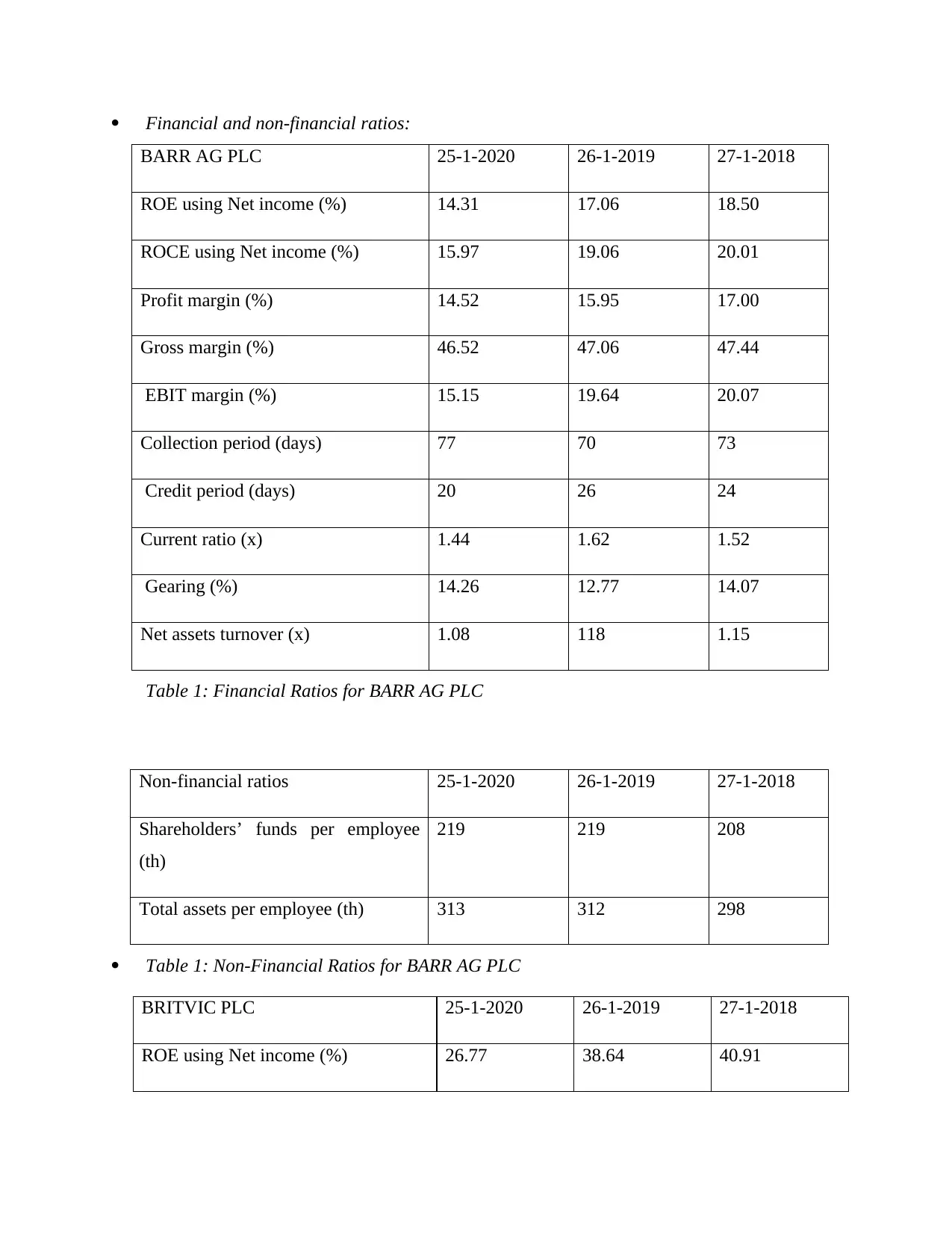
Financial and non-financial ratios:
BARR AG PLC 25-1-2020 26-1-2019 27-1-2018
ROE using Net income (%) 14.31 17.06 18.50
ROCE using Net income (%) 15.97 19.06 20.01
Profit margin (%) 14.52 15.95 17.00
Gross margin (%) 46.52 47.06 47.44
EBIT margin (%) 15.15 19.64 20.07
Collection period (days) 77 70 73
Credit period (days) 20 26 24
Current ratio (x) 1.44 1.62 1.52
Gearing (%) 14.26 12.77 14.07
Net assets turnover (x) 1.08 118 1.15
Table 1: Financial Ratios for BARR AG PLC
Non-financial ratios 25-1-2020 26-1-2019 27-1-2018
Shareholders’ funds per employee
(th)
219 219 208
Total assets per employee (th) 313 312 298
Table 1: Non-Financial Ratios for BARR AG PLC
BRITVIC PLC 25-1-2020 26-1-2019 27-1-2018
ROE using Net income (%) 26.77 38.64 40.91
BARR AG PLC 25-1-2020 26-1-2019 27-1-2018
ROE using Net income (%) 14.31 17.06 18.50
ROCE using Net income (%) 15.97 19.06 20.01
Profit margin (%) 14.52 15.95 17.00
Gross margin (%) 46.52 47.06 47.44
EBIT margin (%) 15.15 19.64 20.07
Collection period (days) 77 70 73
Credit period (days) 20 26 24
Current ratio (x) 1.44 1.62 1.52
Gearing (%) 14.26 12.77 14.07
Net assets turnover (x) 1.08 118 1.15
Table 1: Financial Ratios for BARR AG PLC
Non-financial ratios 25-1-2020 26-1-2019 27-1-2018
Shareholders’ funds per employee
(th)
219 219 208
Total assets per employee (th) 313 312 298
Table 1: Non-Financial Ratios for BARR AG PLC
BRITVIC PLC 25-1-2020 26-1-2019 27-1-2018
ROE using Net income (%) 26.77 38.64 40.91
Paraphrase This Document
Need a fresh take? Get an instant paraphrase of this document with our AI Paraphraser
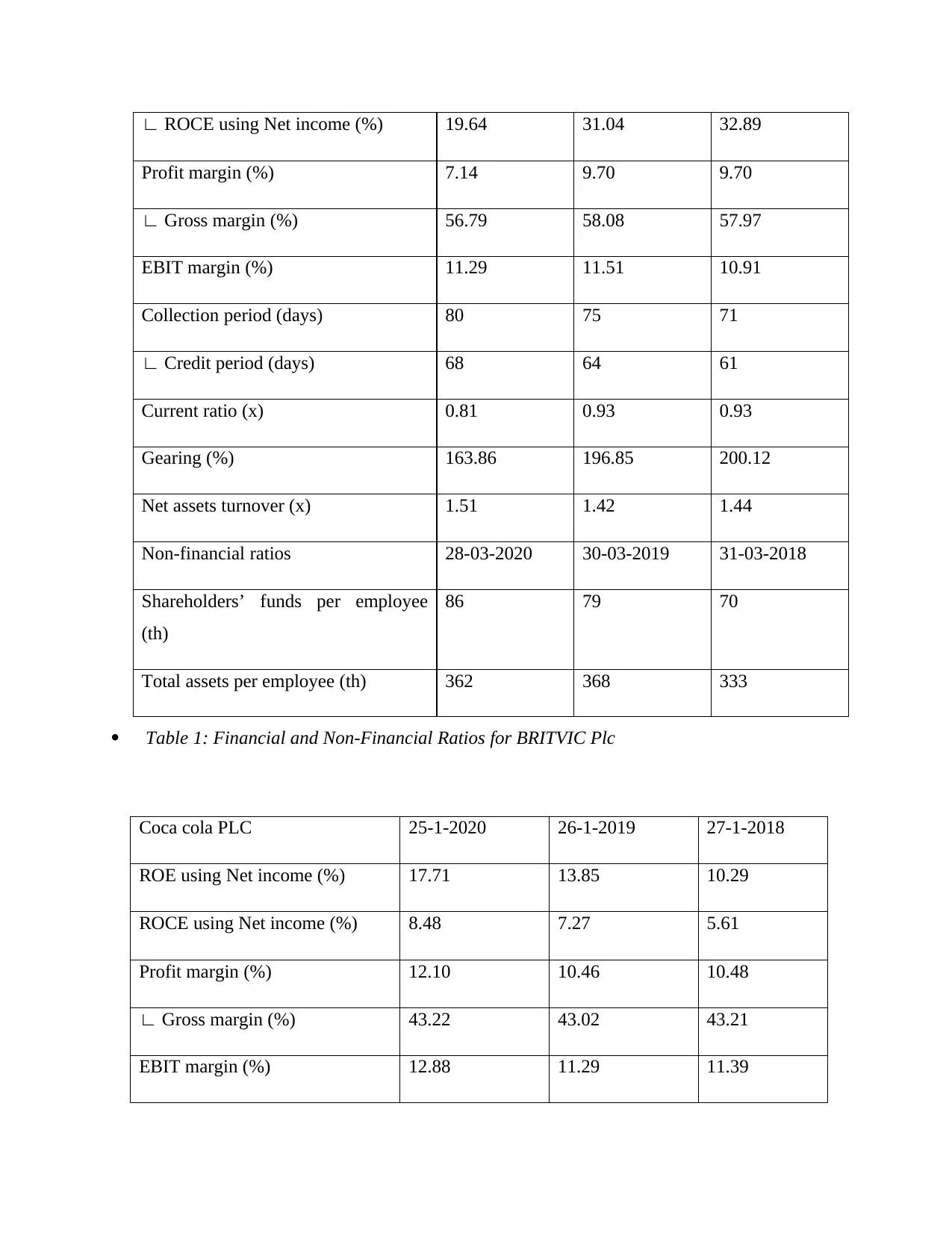
∟ ROCE using Net income (%) 19.64 31.04 32.89
Profit margin (%) 7.14 9.70 9.70
∟ Gross margin (%) 56.79 58.08 57.97
EBIT margin (%) 11.29 11.51 10.91
Collection period (days) 80 75 71
∟ Credit period (days) 68 64 61
Current ratio (x) 0.81 0.93 0.93
Gearing (%) 163.86 196.85 200.12
Net assets turnover (x) 1.51 1.42 1.44
Non-financial ratios 28-03-2020 30-03-2019 31-03-2018
Shareholders’ funds per employee
(th)
86 79 70
Total assets per employee (th) 362 368 333
Table 1: Financial and Non-Financial Ratios for BRITVIC Plc
Coca cola PLC 25-1-2020 26-1-2019 27-1-2018
ROE using Net income (%) 17.71 13.85 10.29
ROCE using Net income (%) 8.48 7.27 5.61
Profit margin (%) 12.10 10.46 10.48
∟ Gross margin (%) 43.22 43.02 43.21
EBIT margin (%) 12.88 11.29 11.39
Profit margin (%) 7.14 9.70 9.70
∟ Gross margin (%) 56.79 58.08 57.97
EBIT margin (%) 11.29 11.51 10.91
Collection period (days) 80 75 71
∟ Credit period (days) 68 64 61
Current ratio (x) 0.81 0.93 0.93
Gearing (%) 163.86 196.85 200.12
Net assets turnover (x) 1.51 1.42 1.44
Non-financial ratios 28-03-2020 30-03-2019 31-03-2018
Shareholders’ funds per employee
(th)
86 79 70
Total assets per employee (th) 362 368 333
Table 1: Financial and Non-Financial Ratios for BRITVIC Plc
Coca cola PLC 25-1-2020 26-1-2019 27-1-2018
ROE using Net income (%) 17.71 13.85 10.29
ROCE using Net income (%) 8.48 7.27 5.61
Profit margin (%) 12.10 10.46 10.48
∟ Gross margin (%) 43.22 43.02 43.21
EBIT margin (%) 12.88 11.29 11.39
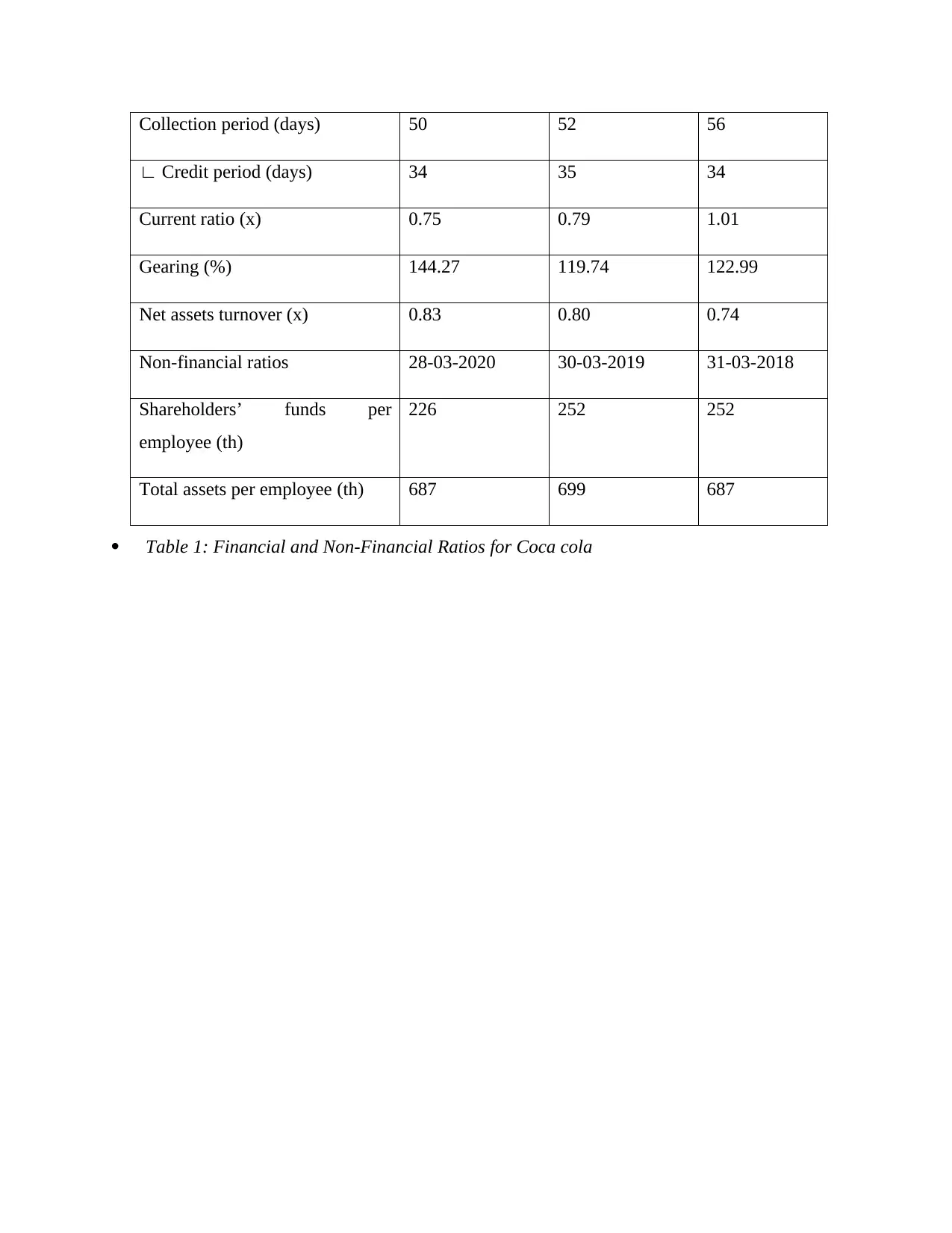
Collection period (days) 50 52 56
∟ Credit period (days) 34 35 34
Current ratio (x) 0.75 0.79 1.01
Gearing (%) 144.27 119.74 122.99
Net assets turnover (x) 0.83 0.80 0.74
Non-financial ratios 28-03-2020 30-03-2019 31-03-2018
Shareholders’ funds per
employee (th)
226 252 252
Total assets per employee (th) 687 699 687
Table 1: Financial and Non-Financial Ratios for Coca cola
∟ Credit period (days) 34 35 34
Current ratio (x) 0.75 0.79 1.01
Gearing (%) 144.27 119.74 122.99
Net assets turnover (x) 0.83 0.80 0.74
Non-financial ratios 28-03-2020 30-03-2019 31-03-2018
Shareholders’ funds per
employee (th)
226 252 252
Total assets per employee (th) 687 699 687
Table 1: Financial and Non-Financial Ratios for Coca cola
⊘ This is a preview!⊘
Do you want full access?
Subscribe today to unlock all pages.

Trusted by 1+ million students worldwide
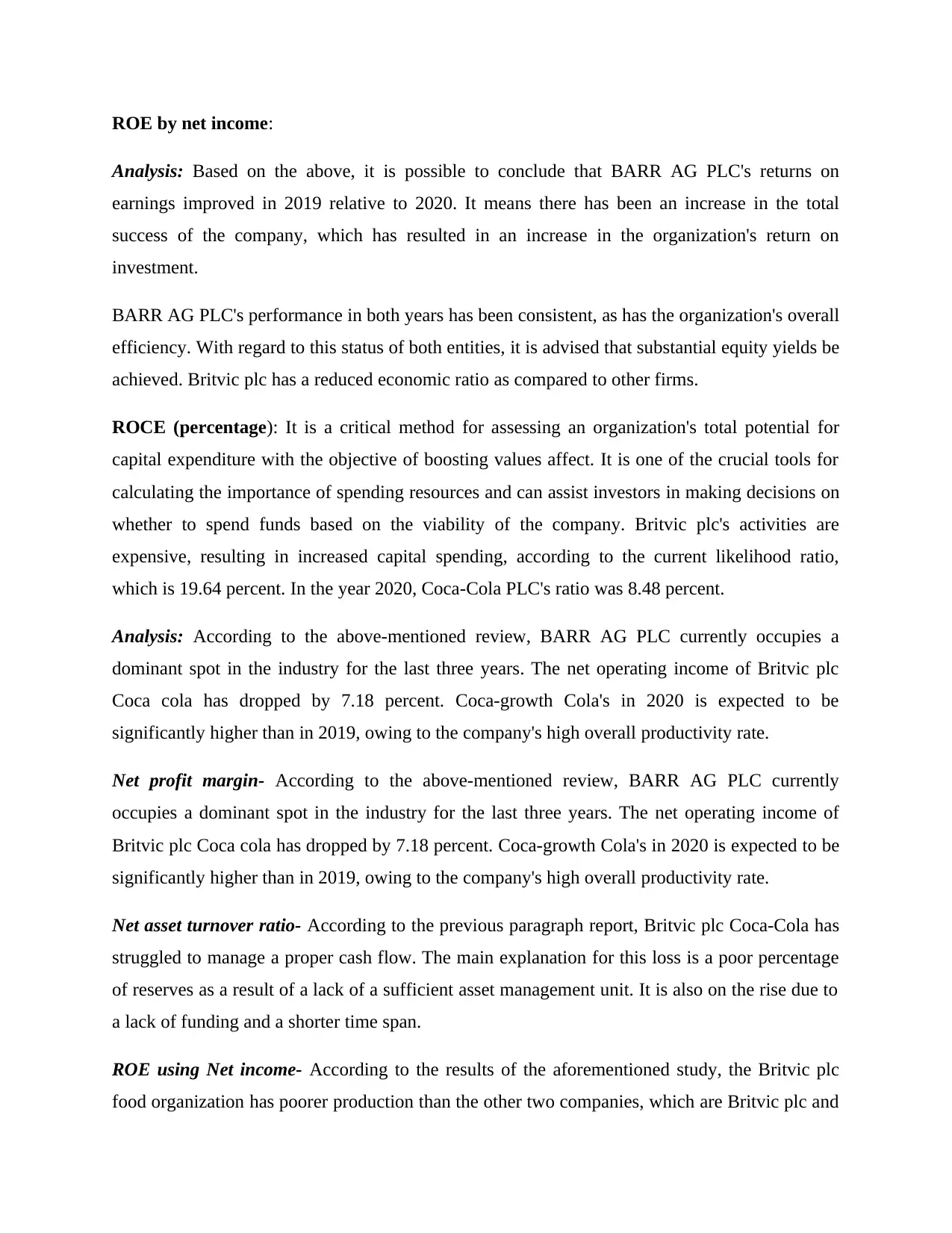
ROE by net income:
Analysis: Based on the above, it is possible to conclude that BARR AG PLC's returns on
earnings improved in 2019 relative to 2020. It means there has been an increase in the total
success of the company, which has resulted in an increase in the organization's return on
investment.
BARR AG PLC's performance in both years has been consistent, as has the organization's overall
efficiency. With regard to this status of both entities, it is advised that substantial equity yields be
achieved. Britvic plc has a reduced economic ratio as compared to other firms.
ROCE (percentage): It is a critical method for assessing an organization's total potential for
capital expenditure with the objective of boosting values affect. It is one of the crucial tools for
calculating the importance of spending resources and can assist investors in making decisions on
whether to spend funds based on the viability of the company. Britvic plc's activities are
expensive, resulting in increased capital spending, according to the current likelihood ratio,
which is 19.64 percent. In the year 2020, Coca-Cola PLC's ratio was 8.48 percent.
Analysis: According to the above-mentioned review, BARR AG PLC currently occupies a
dominant spot in the industry for the last three years. The net operating income of Britvic plc
Coca cola has dropped by 7.18 percent. Coca-growth Cola's in 2020 is expected to be
significantly higher than in 2019, owing to the company's high overall productivity rate.
Net profit margin- According to the above-mentioned review, BARR AG PLC currently
occupies a dominant spot in the industry for the last three years. The net operating income of
Britvic plc Coca cola has dropped by 7.18 percent. Coca-growth Cola's in 2020 is expected to be
significantly higher than in 2019, owing to the company's high overall productivity rate.
Net asset turnover ratio- According to the previous paragraph report, Britvic plc Coca-Cola has
struggled to manage a proper cash flow. The main explanation for this loss is a poor percentage
of reserves as a result of a lack of a sufficient asset management unit. It is also on the rise due to
a lack of funding and a shorter time span.
ROE using Net income- According to the results of the aforementioned study, the Britvic plc
food organization has poorer production than the other two companies, which are Britvic plc and
Analysis: Based on the above, it is possible to conclude that BARR AG PLC's returns on
earnings improved in 2019 relative to 2020. It means there has been an increase in the total
success of the company, which has resulted in an increase in the organization's return on
investment.
BARR AG PLC's performance in both years has been consistent, as has the organization's overall
efficiency. With regard to this status of both entities, it is advised that substantial equity yields be
achieved. Britvic plc has a reduced economic ratio as compared to other firms.
ROCE (percentage): It is a critical method for assessing an organization's total potential for
capital expenditure with the objective of boosting values affect. It is one of the crucial tools for
calculating the importance of spending resources and can assist investors in making decisions on
whether to spend funds based on the viability of the company. Britvic plc's activities are
expensive, resulting in increased capital spending, according to the current likelihood ratio,
which is 19.64 percent. In the year 2020, Coca-Cola PLC's ratio was 8.48 percent.
Analysis: According to the above-mentioned review, BARR AG PLC currently occupies a
dominant spot in the industry for the last three years. The net operating income of Britvic plc
Coca cola has dropped by 7.18 percent. Coca-growth Cola's in 2020 is expected to be
significantly higher than in 2019, owing to the company's high overall productivity rate.
Net profit margin- According to the above-mentioned review, BARR AG PLC currently
occupies a dominant spot in the industry for the last three years. The net operating income of
Britvic plc Coca cola has dropped by 7.18 percent. Coca-growth Cola's in 2020 is expected to be
significantly higher than in 2019, owing to the company's high overall productivity rate.
Net asset turnover ratio- According to the previous paragraph report, Britvic plc Coca-Cola has
struggled to manage a proper cash flow. The main explanation for this loss is a poor percentage
of reserves as a result of a lack of a sufficient asset management unit. It is also on the rise due to
a lack of funding and a shorter time span.
ROE using Net income- According to the results of the aforementioned study, the Britvic plc
food organization has poorer production than the other two companies, which are Britvic plc and
Paraphrase This Document
Need a fresh take? Get an instant paraphrase of this document with our AI Paraphraser
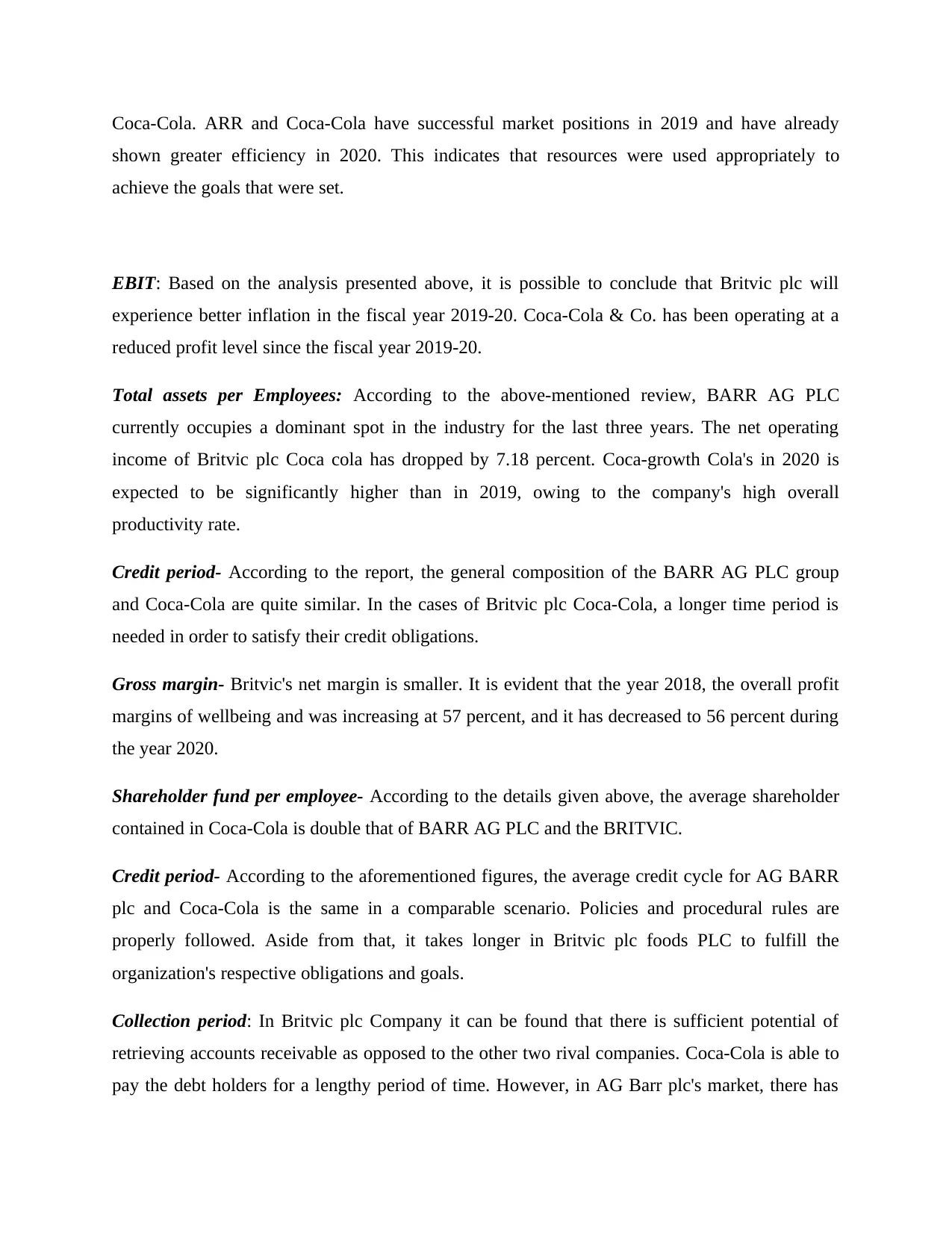
Coca-Cola. ARR and Coca-Cola have successful market positions in 2019 and have already
shown greater efficiency in 2020. This indicates that resources were used appropriately to
achieve the goals that were set.
EBIT: Based on the analysis presented above, it is possible to conclude that Britvic plc will
experience better inflation in the fiscal year 2019-20. Coca-Cola & Co. has been operating at a
reduced profit level since the fiscal year 2019-20.
Total assets per Employees: According to the above-mentioned review, BARR AG PLC
currently occupies a dominant spot in the industry for the last three years. The net operating
income of Britvic plc Coca cola has dropped by 7.18 percent. Coca-growth Cola's in 2020 is
expected to be significantly higher than in 2019, owing to the company's high overall
productivity rate.
Credit period- According to the report, the general composition of the BARR AG PLC group
and Coca-Cola are quite similar. In the cases of Britvic plc Coca-Cola, a longer time period is
needed in order to satisfy their credit obligations.
Gross margin- Britvic's net margin is smaller. It is evident that the year 2018, the overall profit
margins of wellbeing and was increasing at 57 percent, and it has decreased to 56 percent during
the year 2020.
Shareholder fund per employee- According to the details given above, the average shareholder
contained in Coca-Cola is double that of BARR AG PLC and the BRITVIC.
Credit period- According to the aforementioned figures, the average credit cycle for AG BARR
plc and Coca-Cola is the same in a comparable scenario. Policies and procedural rules are
properly followed. Aside from that, it takes longer in Britvic plc foods PLC to fulfill the
organization's respective obligations and goals.
Collection period: In Britvic plc Company it can be found that there is sufficient potential of
retrieving accounts receivable as opposed to the other two rival companies. Coca-Cola is able to
pay the debt holders for a lengthy period of time. However, in AG Barr plc's market, there has
shown greater efficiency in 2020. This indicates that resources were used appropriately to
achieve the goals that were set.
EBIT: Based on the analysis presented above, it is possible to conclude that Britvic plc will
experience better inflation in the fiscal year 2019-20. Coca-Cola & Co. has been operating at a
reduced profit level since the fiscal year 2019-20.
Total assets per Employees: According to the above-mentioned review, BARR AG PLC
currently occupies a dominant spot in the industry for the last three years. The net operating
income of Britvic plc Coca cola has dropped by 7.18 percent. Coca-growth Cola's in 2020 is
expected to be significantly higher than in 2019, owing to the company's high overall
productivity rate.
Credit period- According to the report, the general composition of the BARR AG PLC group
and Coca-Cola are quite similar. In the cases of Britvic plc Coca-Cola, a longer time period is
needed in order to satisfy their credit obligations.
Gross margin- Britvic's net margin is smaller. It is evident that the year 2018, the overall profit
margins of wellbeing and was increasing at 57 percent, and it has decreased to 56 percent during
the year 2020.
Shareholder fund per employee- According to the details given above, the average shareholder
contained in Coca-Cola is double that of BARR AG PLC and the BRITVIC.
Credit period- According to the aforementioned figures, the average credit cycle for AG BARR
plc and Coca-Cola is the same in a comparable scenario. Policies and procedural rules are
properly followed. Aside from that, it takes longer in Britvic plc foods PLC to fulfill the
organization's respective obligations and goals.
Collection period: In Britvic plc Company it can be found that there is sufficient potential of
retrieving accounts receivable as opposed to the other two rival companies. Coca-Cola is able to
pay the debt holders for a lengthy period of time. However, in AG Barr plc's market, there has
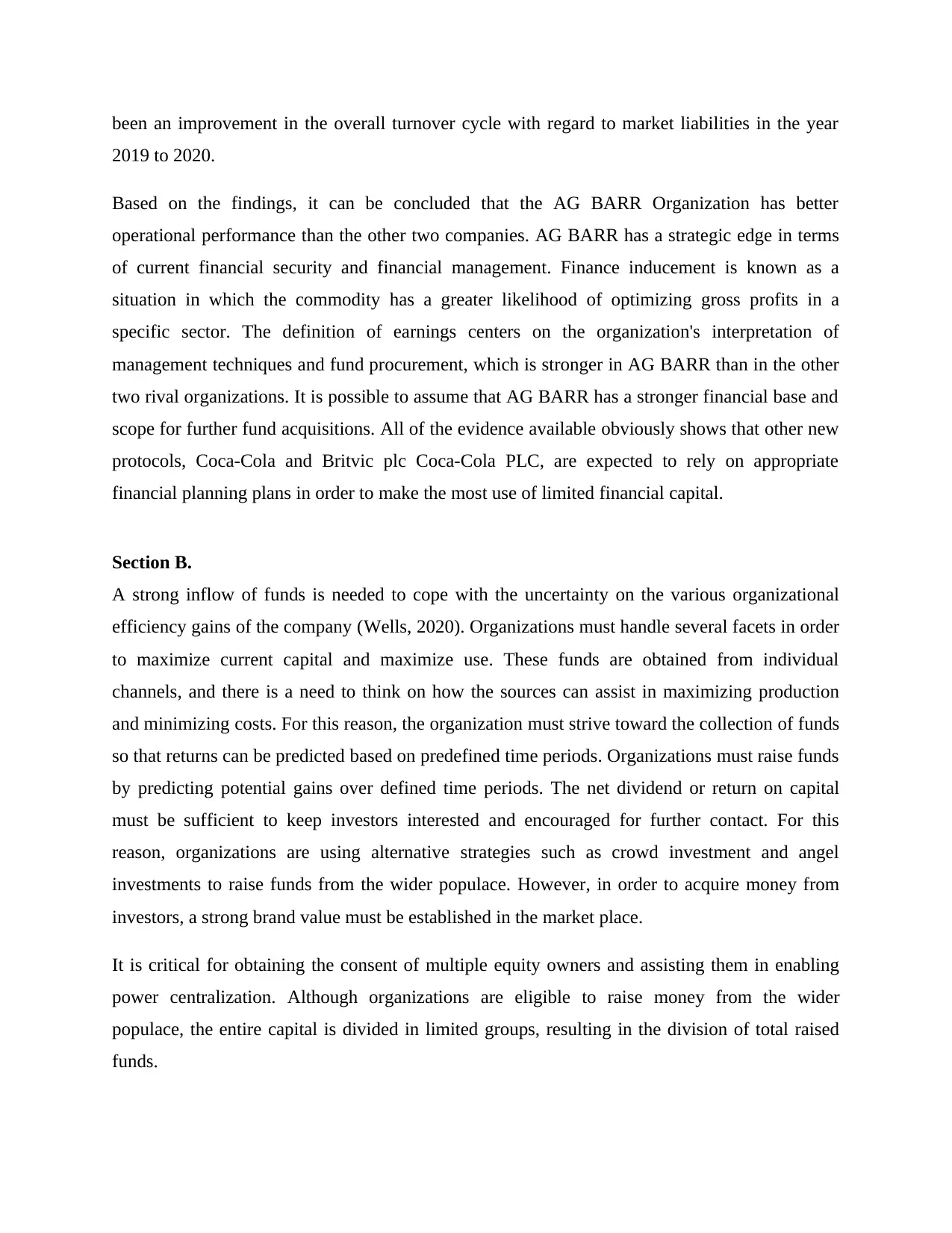
been an improvement in the overall turnover cycle with regard to market liabilities in the year
2019 to 2020.
Based on the findings, it can be concluded that the AG BARR Organization has better
operational performance than the other two companies. AG BARR has a strategic edge in terms
of current financial security and financial management. Finance inducement is known as a
situation in which the commodity has a greater likelihood of optimizing gross profits in a
specific sector. The definition of earnings centers on the organization's interpretation of
management techniques and fund procurement, which is stronger in AG BARR than in the other
two rival organizations. It is possible to assume that AG BARR has a stronger financial base and
scope for further fund acquisitions. All of the evidence available obviously shows that other new
protocols, Coca-Cola and Britvic plc Coca-Cola PLC, are expected to rely on appropriate
financial planning plans in order to make the most use of limited financial capital.
Section B.
A strong inflow of funds is needed to cope with the uncertainty on the various organizational
efficiency gains of the company (Wells, 2020). Organizations must handle several facets in order
to maximize current capital and maximize use. These funds are obtained from individual
channels, and there is a need to think on how the sources can assist in maximizing production
and minimizing costs. For this reason, the organization must strive toward the collection of funds
so that returns can be predicted based on predefined time periods. Organizations must raise funds
by predicting potential gains over defined time periods. The net dividend or return on capital
must be sufficient to keep investors interested and encouraged for further contact. For this
reason, organizations are using alternative strategies such as crowd investment and angel
investments to raise funds from the wider populace. However, in order to acquire money from
investors, a strong brand value must be established in the market place.
It is critical for obtaining the consent of multiple equity owners and assisting them in enabling
power centralization. Although organizations are eligible to raise money from the wider
populace, the entire capital is divided in limited groups, resulting in the division of total raised
funds.
2019 to 2020.
Based on the findings, it can be concluded that the AG BARR Organization has better
operational performance than the other two companies. AG BARR has a strategic edge in terms
of current financial security and financial management. Finance inducement is known as a
situation in which the commodity has a greater likelihood of optimizing gross profits in a
specific sector. The definition of earnings centers on the organization's interpretation of
management techniques and fund procurement, which is stronger in AG BARR than in the other
two rival organizations. It is possible to assume that AG BARR has a stronger financial base and
scope for further fund acquisitions. All of the evidence available obviously shows that other new
protocols, Coca-Cola and Britvic plc Coca-Cola PLC, are expected to rely on appropriate
financial planning plans in order to make the most use of limited financial capital.
Section B.
A strong inflow of funds is needed to cope with the uncertainty on the various organizational
efficiency gains of the company (Wells, 2020). Organizations must handle several facets in order
to maximize current capital and maximize use. These funds are obtained from individual
channels, and there is a need to think on how the sources can assist in maximizing production
and minimizing costs. For this reason, the organization must strive toward the collection of funds
so that returns can be predicted based on predefined time periods. Organizations must raise funds
by predicting potential gains over defined time periods. The net dividend or return on capital
must be sufficient to keep investors interested and encouraged for further contact. For this
reason, organizations are using alternative strategies such as crowd investment and angel
investments to raise funds from the wider populace. However, in order to acquire money from
investors, a strong brand value must be established in the market place.
It is critical for obtaining the consent of multiple equity owners and assisting them in enabling
power centralization. Although organizations are eligible to raise money from the wider
populace, the entire capital is divided in limited groups, resulting in the division of total raised
funds.
⊘ This is a preview!⊘
Do you want full access?
Subscribe today to unlock all pages.

Trusted by 1+ million students worldwide
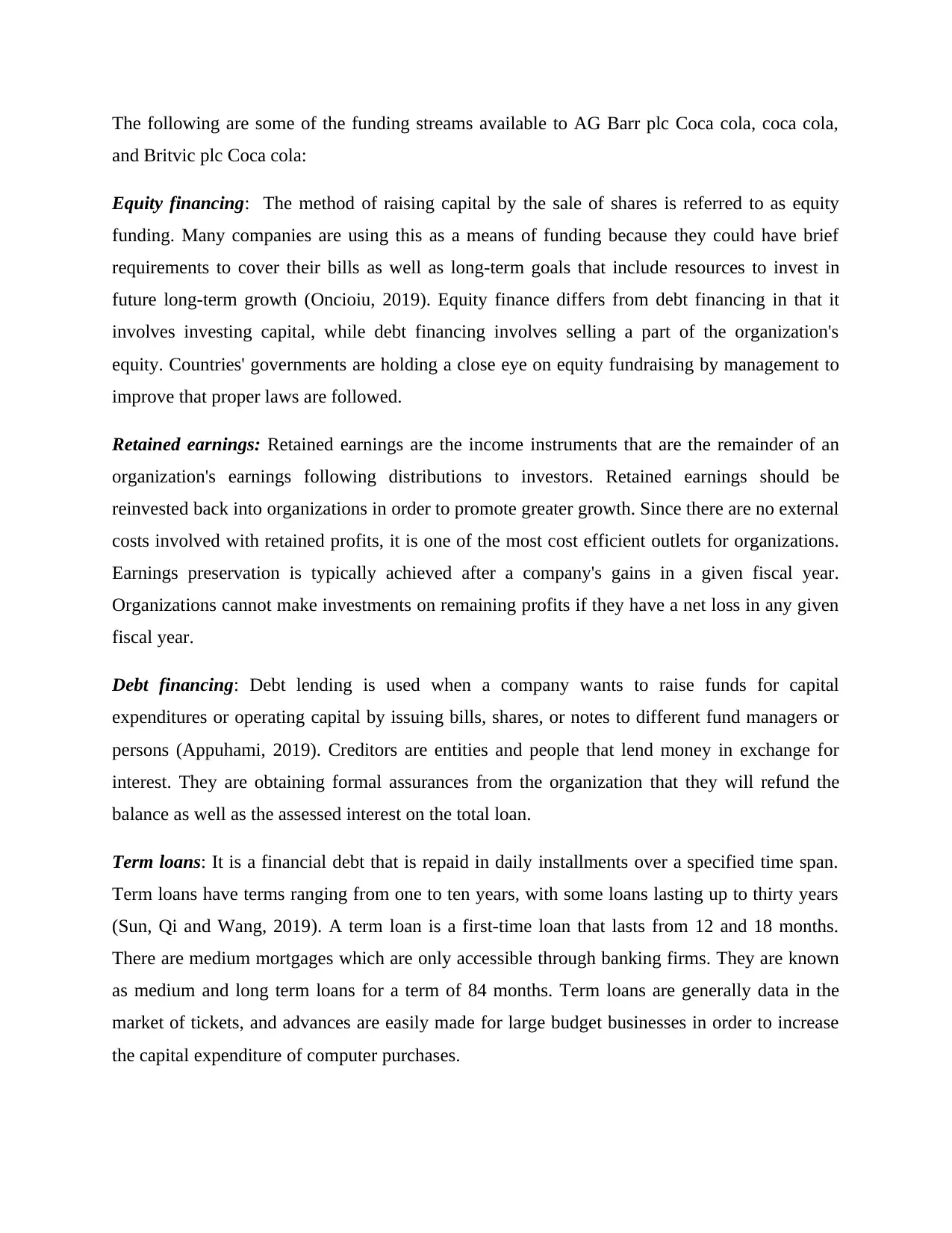
The following are some of the funding streams available to AG Barr plc Coca cola, coca cola,
and Britvic plc Coca cola:
Equity financing: The method of raising capital by the sale of shares is referred to as equity
funding. Many companies are using this as a means of funding because they could have brief
requirements to cover their bills as well as long-term goals that include resources to invest in
future long-term growth (Oncioiu, 2019). Equity finance differs from debt financing in that it
involves investing capital, while debt financing involves selling a part of the organization's
equity. Countries' governments are holding a close eye on equity fundraising by management to
improve that proper laws are followed.
Retained earnings: Retained earnings are the income instruments that are the remainder of an
organization's earnings following distributions to investors. Retained earnings should be
reinvested back into organizations in order to promote greater growth. Since there are no external
costs involved with retained profits, it is one of the most cost efficient outlets for organizations.
Earnings preservation is typically achieved after a company's gains in a given fiscal year.
Organizations cannot make investments on remaining profits if they have a net loss in any given
fiscal year.
Debt financing: Debt lending is used when a company wants to raise funds for capital
expenditures or operating capital by issuing bills, shares, or notes to different fund managers or
persons (Appuhami, 2019). Creditors are entities and people that lend money in exchange for
interest. They are obtaining formal assurances from the organization that they will refund the
balance as well as the assessed interest on the total loan.
Term loans: It is a financial debt that is repaid in daily installments over a specified time span.
Term loans have terms ranging from one to ten years, with some loans lasting up to thirty years
(Sun, Qi and Wang, 2019). A term loan is a first-time loan that lasts from 12 and 18 months.
There are medium mortgages which are only accessible through banking firms. They are known
as medium and long term loans for a term of 84 months. Term loans are generally data in the
market of tickets, and advances are easily made for large budget businesses in order to increase
the capital expenditure of computer purchases.
and Britvic plc Coca cola:
Equity financing: The method of raising capital by the sale of shares is referred to as equity
funding. Many companies are using this as a means of funding because they could have brief
requirements to cover their bills as well as long-term goals that include resources to invest in
future long-term growth (Oncioiu, 2019). Equity finance differs from debt financing in that it
involves investing capital, while debt financing involves selling a part of the organization's
equity. Countries' governments are holding a close eye on equity fundraising by management to
improve that proper laws are followed.
Retained earnings: Retained earnings are the income instruments that are the remainder of an
organization's earnings following distributions to investors. Retained earnings should be
reinvested back into organizations in order to promote greater growth. Since there are no external
costs involved with retained profits, it is one of the most cost efficient outlets for organizations.
Earnings preservation is typically achieved after a company's gains in a given fiscal year.
Organizations cannot make investments on remaining profits if they have a net loss in any given
fiscal year.
Debt financing: Debt lending is used when a company wants to raise funds for capital
expenditures or operating capital by issuing bills, shares, or notes to different fund managers or
persons (Appuhami, 2019). Creditors are entities and people that lend money in exchange for
interest. They are obtaining formal assurances from the organization that they will refund the
balance as well as the assessed interest on the total loan.
Term loans: It is a financial debt that is repaid in daily installments over a specified time span.
Term loans have terms ranging from one to ten years, with some loans lasting up to thirty years
(Sun, Qi and Wang, 2019). A term loan is a first-time loan that lasts from 12 and 18 months.
There are medium mortgages which are only accessible through banking firms. They are known
as medium and long term loans for a term of 84 months. Term loans are generally data in the
market of tickets, and advances are easily made for large budget businesses in order to increase
the capital expenditure of computer purchases.
Paraphrase This Document
Need a fresh take? Get an instant paraphrase of this document with our AI Paraphraser
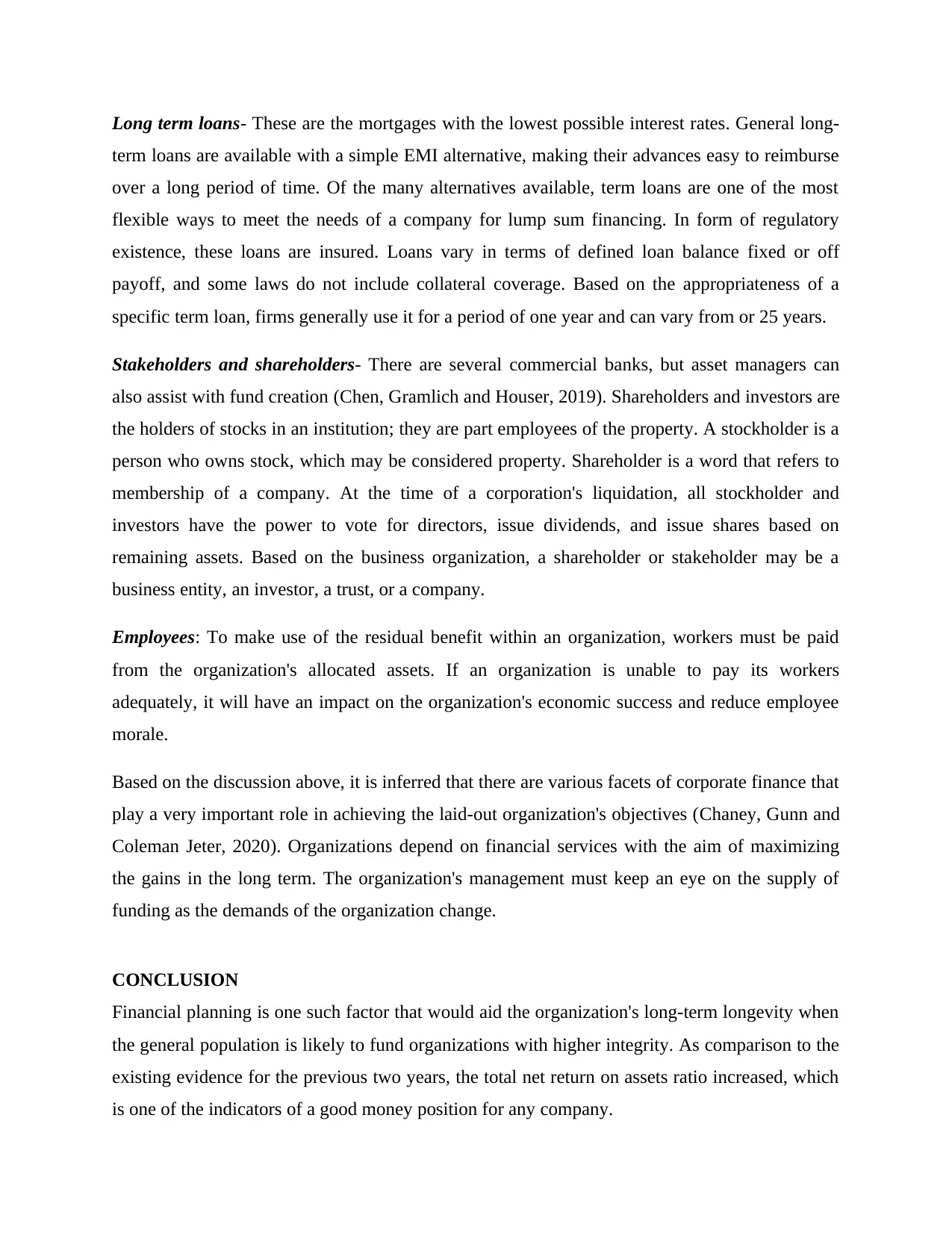
Long term loans- These are the mortgages with the lowest possible interest rates. General long-
term loans are available with a simple EMI alternative, making their advances easy to reimburse
over a long period of time. Of the many alternatives available, term loans are one of the most
flexible ways to meet the needs of a company for lump sum financing. In form of regulatory
existence, these loans are insured. Loans vary in terms of defined loan balance fixed or off
payoff, and some laws do not include collateral coverage. Based on the appropriateness of a
specific term loan, firms generally use it for a period of one year and can vary from or 25 years.
Stakeholders and shareholders- There are several commercial banks, but asset managers can
also assist with fund creation (Chen, Gramlich and Houser, 2019). Shareholders and investors are
the holders of stocks in an institution; they are part employees of the property. A stockholder is a
person who owns stock, which may be considered property. Shareholder is a word that refers to
membership of a company. At the time of a corporation's liquidation, all stockholder and
investors have the power to vote for directors, issue dividends, and issue shares based on
remaining assets. Based on the business organization, a shareholder or stakeholder may be a
business entity, an investor, a trust, or a company.
Employees: To make use of the residual benefit within an organization, workers must be paid
from the organization's allocated assets. If an organization is unable to pay its workers
adequately, it will have an impact on the organization's economic success and reduce employee
morale.
Based on the discussion above, it is inferred that there are various facets of corporate finance that
play a very important role in achieving the laid-out organization's objectives (Chaney, Gunn and
Coleman Jeter, 2020). Organizations depend on financial services with the aim of maximizing
the gains in the long term. The organization's management must keep an eye on the supply of
funding as the demands of the organization change.
CONCLUSION
Financial planning is one such factor that would aid the organization's long-term longevity when
the general population is likely to fund organizations with higher integrity. As comparison to the
existing evidence for the previous two years, the total net return on assets ratio increased, which
is one of the indicators of a good money position for any company.
term loans are available with a simple EMI alternative, making their advances easy to reimburse
over a long period of time. Of the many alternatives available, term loans are one of the most
flexible ways to meet the needs of a company for lump sum financing. In form of regulatory
existence, these loans are insured. Loans vary in terms of defined loan balance fixed or off
payoff, and some laws do not include collateral coverage. Based on the appropriateness of a
specific term loan, firms generally use it for a period of one year and can vary from or 25 years.
Stakeholders and shareholders- There are several commercial banks, but asset managers can
also assist with fund creation (Chen, Gramlich and Houser, 2019). Shareholders and investors are
the holders of stocks in an institution; they are part employees of the property. A stockholder is a
person who owns stock, which may be considered property. Shareholder is a word that refers to
membership of a company. At the time of a corporation's liquidation, all stockholder and
investors have the power to vote for directors, issue dividends, and issue shares based on
remaining assets. Based on the business organization, a shareholder or stakeholder may be a
business entity, an investor, a trust, or a company.
Employees: To make use of the residual benefit within an organization, workers must be paid
from the organization's allocated assets. If an organization is unable to pay its workers
adequately, it will have an impact on the organization's economic success and reduce employee
morale.
Based on the discussion above, it is inferred that there are various facets of corporate finance that
play a very important role in achieving the laid-out organization's objectives (Chaney, Gunn and
Coleman Jeter, 2020). Organizations depend on financial services with the aim of maximizing
the gains in the long term. The organization's management must keep an eye on the supply of
funding as the demands of the organization change.
CONCLUSION
Financial planning is one such factor that would aid the organization's long-term longevity when
the general population is likely to fund organizations with higher integrity. As comparison to the
existing evidence for the previous two years, the total net return on assets ratio increased, which
is one of the indicators of a good money position for any company.
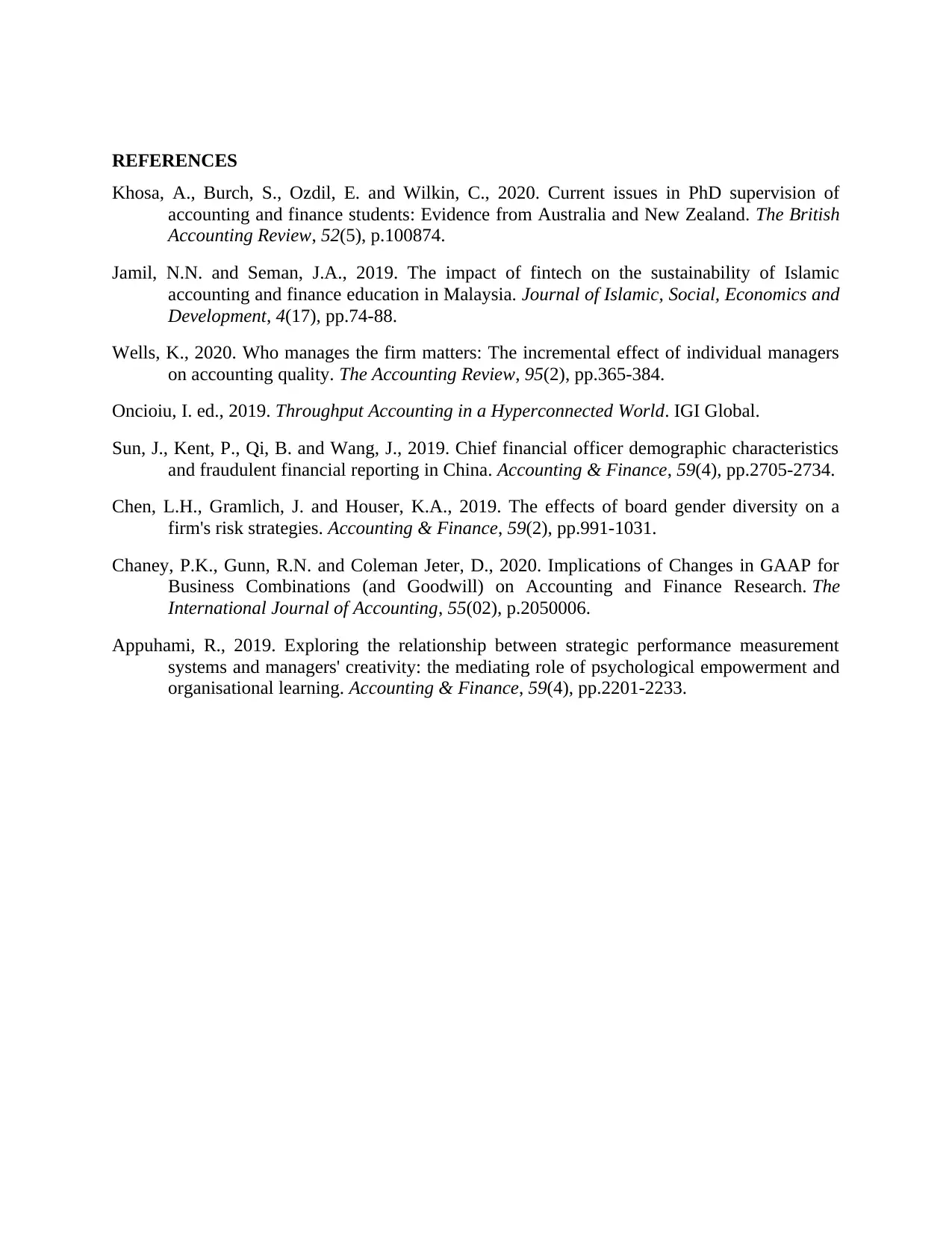
REFERENCES
Khosa, A., Burch, S., Ozdil, E. and Wilkin, C., 2020. Current issues in PhD supervision of
accounting and finance students: Evidence from Australia and New Zealand. The British
Accounting Review, 52(5), p.100874.
Jamil, N.N. and Seman, J.A., 2019. The impact of fintech on the sustainability of Islamic
accounting and finance education in Malaysia. Journal of Islamic, Social, Economics and
Development, 4(17), pp.74-88.
Wells, K., 2020. Who manages the firm matters: The incremental effect of individual managers
on accounting quality. The Accounting Review, 95(2), pp.365-384.
Oncioiu, I. ed., 2019. Throughput Accounting in a Hyperconnected World. IGI Global.
Sun, J., Kent, P., Qi, B. and Wang, J., 2019. Chief financial officer demographic characteristics
and fraudulent financial reporting in China. Accounting & Finance, 59(4), pp.2705-2734.
Chen, L.H., Gramlich, J. and Houser, K.A., 2019. The effects of board gender diversity on a
firm's risk strategies. Accounting & Finance, 59(2), pp.991-1031.
Chaney, P.K., Gunn, R.N. and Coleman Jeter, D., 2020. Implications of Changes in GAAP for
Business Combinations (and Goodwill) on Accounting and Finance Research. The
International Journal of Accounting, 55(02), p.2050006.
Appuhami, R., 2019. Exploring the relationship between strategic performance measurement
systems and managers' creativity: the mediating role of psychological empowerment and
organisational learning. Accounting & Finance, 59(4), pp.2201-2233.
Khosa, A., Burch, S., Ozdil, E. and Wilkin, C., 2020. Current issues in PhD supervision of
accounting and finance students: Evidence from Australia and New Zealand. The British
Accounting Review, 52(5), p.100874.
Jamil, N.N. and Seman, J.A., 2019. The impact of fintech on the sustainability of Islamic
accounting and finance education in Malaysia. Journal of Islamic, Social, Economics and
Development, 4(17), pp.74-88.
Wells, K., 2020. Who manages the firm matters: The incremental effect of individual managers
on accounting quality. The Accounting Review, 95(2), pp.365-384.
Oncioiu, I. ed., 2019. Throughput Accounting in a Hyperconnected World. IGI Global.
Sun, J., Kent, P., Qi, B. and Wang, J., 2019. Chief financial officer demographic characteristics
and fraudulent financial reporting in China. Accounting & Finance, 59(4), pp.2705-2734.
Chen, L.H., Gramlich, J. and Houser, K.A., 2019. The effects of board gender diversity on a
firm's risk strategies. Accounting & Finance, 59(2), pp.991-1031.
Chaney, P.K., Gunn, R.N. and Coleman Jeter, D., 2020. Implications of Changes in GAAP for
Business Combinations (and Goodwill) on Accounting and Finance Research. The
International Journal of Accounting, 55(02), p.2050006.
Appuhami, R., 2019. Exploring the relationship between strategic performance measurement
systems and managers' creativity: the mediating role of psychological empowerment and
organisational learning. Accounting & Finance, 59(4), pp.2201-2233.
⊘ This is a preview!⊘
Do you want full access?
Subscribe today to unlock all pages.

Trusted by 1+ million students worldwide
1 out of 12
Related Documents
Your All-in-One AI-Powered Toolkit for Academic Success.
+13062052269
info@desklib.com
Available 24*7 on WhatsApp / Email
![[object Object]](/_next/static/media/star-bottom.7253800d.svg)
Unlock your academic potential
Copyright © 2020–2025 A2Z Services. All Rights Reserved. Developed and managed by ZUCOL.





